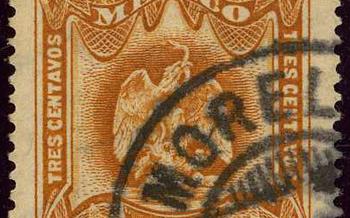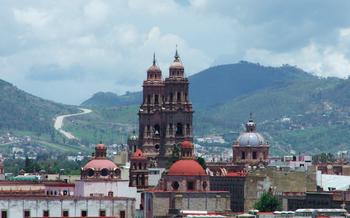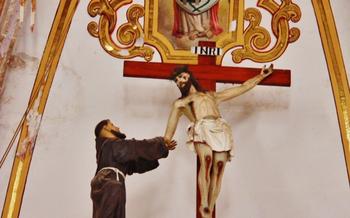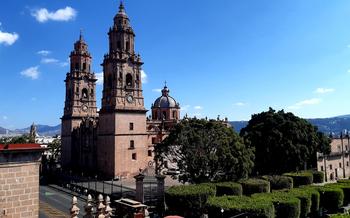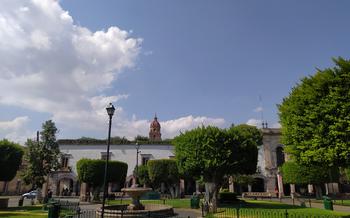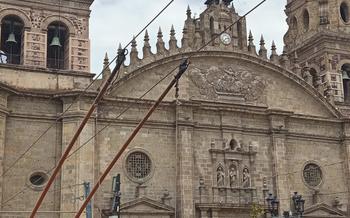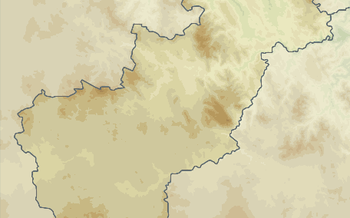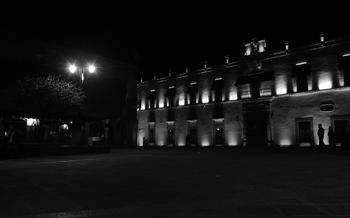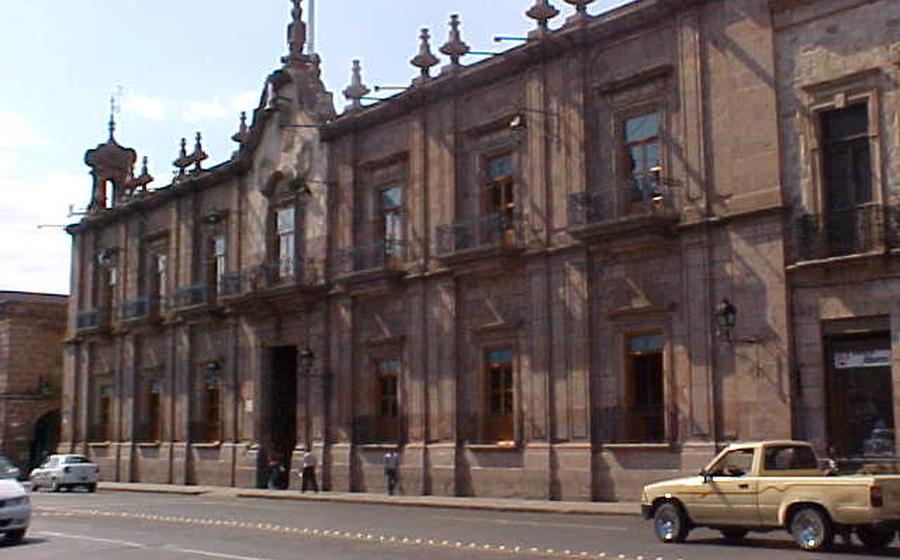
Palacio de Gobierno
- Palacio de Gobierno: A Majestic Palace in Morelia
- Architectural Masterpiece: A Fusion of Styles
- Alfredo Zalce's Murals: A Visual Narrative of Mexican History
- Guided Tours: Unveiling the Palace's Secrets
- Exploring the Palace's Interior: A Journey Through History
- Practical Information for Visitors: Planning Your Visit
- Palacio de Gobierno in Popular Culture: A Setting for Art and Media
- Nearby Attractions: Enriching Your Morelia Experience
- Sustainability and Conservation Efforts: Preserving the Palace's Legacy
- Insider Tip: Discovering Morelia's Hidden Gems
Palacio de Gobierno: A Majestic Palace in Morelia
**Explore the Capist, left his mark on the palace with his captivating murals that adorn the building's interior. These murals are a testament to Zalce's artistry and his deep connection to Mexican history and culture.
Zalce's murals depict various scenes from Mexico's past, including the Mexican Revolution, the country's rich indigenous heritage, and the struggles for social justice. His use of vibrant colors, bold lines, and intricate symbolism brings these scenes to life, creating a powerful narrative that invites viewers to reflect on Mexico's journey as a nation.
Practical Information About Guided Tours
Guided tours of the Palacio de Gobierno are available to provide visitors with a deeper understanding of the palace's history, architecture, and artwork. These tours are conducted by knowledgeable guides who share fascinating insights and anecdotes about the building and its significance to Morelia and Mexico.
Tours are offered in Spanish and English and typically last for about an hour. Visitors can book their spots on a guided tour at the palace's information desk or online. It's recommended to reserve your spot in advance, especially during peak tourist season, to avoid disappointment.
Architectural Masterpiece: A Fusion of Styles
The Palacio de Gobierno is not just a historical landmark but also an architectural marvel that showcases a blend of Baroque and Neoclassical styles. Its façade, adorned with intricate carvings and decorative moldings, reflects the grandeur of Baroque architecture. The building's symmetry, clean lines, and elegant simplicity are reminiscent of Neoclassicism.
Inside the palace, visitors can admire the stunning murals by Alfredo Zalce, which depict key moments in Mexican history. These vibrant and symbolic works of art not only beautify the palace's interiors but also provide a visual narrative of Mexico's past.
Other highlights include the grand staircase, which leads to the upper floors and is adorned with intricate wrought-iron work and decorative elements. The Salón de los Gobernadores, dedicated to the portraits of Michoacán's governors, is another must-see, as it offers a glimpse into the state's political history.
Alfredo Zalce's Murals: A Visual Narrative of Mexican History
Alfredo Zalce, a renowned Mexican muralist, left an indelible mark on the Palacio de Gobierno through his captivating murals that adorn its walls. These murals are not mere works of art but powerful narratives that vividly depict significant events from Mexico's history, particularly the Mexican Revolution and its profound impact on society.
Zalce's murals are a testament to his artistic mastery, showcasing his skillful use of color, composition, and symbolism. The vibrant hues and bold lines create a striking visual impact, drawing viewers into the stories unfolding on the walls. The artist's unique style combines realism and symbolism, allowing him to convey complex historical events in a visually compelling manner.
The murals not only depict historical events but also delve into their deeper meanings and consequences. Zalce's work explores themes of social injustice, political struggles, and the resilience of the Mexican people. Through his murals, he aimed to raise awareness of Mexico's rich history and inspire viewers to reflect on the nation's journey towards progress and social change.
Each mural is a chapter in Mexico's historical narrative, inviting viewers to contemplate the sacrifices, triumphs, and challenges that have shaped the country's identity. Zalce's murals are not just artistic masterpieces but also valuable historical documents that offer a unique perspective on Mexico's past.
Guided Tours: Unveiling the Palace's Secrets
Guided tours offer an immersive experience, allowing visitors to delve into the history, art, and significance of the Palacio de Gobierno. These tours are conducted by knowledgeable guides who provide insights into the palace's architecture, murals, and its role in shaping Morelia's identity.
There are various tour options available, catering to different interests and languages. Standard guided tours are typically offered in Spanish, but English tours are also available upon request. Tours typically last around 45 minutes to an hour, taking visitors through the palace's main courtyard, grand staircase, Salón de los Gobernadores, and Salón del Pueblo.
Reservations for guided tours are recommended, especially for groups or visitors with specific language preferences. You can book your spot online or by contacting the Palacio de Gobierno directly. It's advisable to arrive a few minutes before the scheduled tour time to ensure a smooth start.
Exploring the Palace's Interior: A Journey Through History
Venturing into Palacio de Gobierno's interior is like embarking on a journey through the annals of Morelia's rich history and cultural heritage. The main courtyard, with its elegant arcades and central fountain, sets the tone for what's to come. Here, visitors can pause and admire the building's harmonious architecture, a blend of Baroque and Neoclassical styles.
The grand staircase, with its intricately carved balustrades and soaring height, is a testament to the skill and artistry of the palace's builders. Ascending the stairs, one enters the Salón de los Gobernadores, a hall lined with portraits of Michoacán's past governors, each with a tale to tell.
The Salón del Pueblo, or Hall of the People, stands as a tribute to the diverse communities that make up the state of Michoacán. Murals and paintings depict scenes from everyday life, capturing the essence of the region's culture and traditions.
Other notable rooms include the Salón de Recepciones, used for official functions and ceremonies, and the Biblioteca Pública del Estado, which houses a vast collection of books and documents related to Michoacán's history and literature. Each room offers a glimpse into the palace's past and present, inviting visitors to unravel the stories that lie within its walls.
Practical Information for Visitors: Planning Your Visit
Location and Accessibility:
The Palacio de Gobierno stands proudly at the heart of Morelia's historic center, facing the Plaza de Armas. It is easily accessible by foot or public transportation, making it a convenient destination for visitors exploring the city.
Opening Hours:
The Palacio de Gobierno welcomes visitors from Tuesday to Sunday, offering guided tours at regular intervals. The palace's doors are open from 9:00 AM to 5:00 PM, with extended hours on Saturdays until 7:00 PM. However, it is advisable to check the official website or contact the palace directly for any changes or special arrangements.
Admission Fees:
Admission to the Palacio de Gobierno is affordable and offers excellent value for visitors. The standard entrance fee is nominal, with discounts available for students, seniors, and children. Additionally, free admission is granted on Sundays, allowing visitors to explore the palace's wonders without any financial burden.
Photography Policy:
Capturing the beauty of the Palacio de Gobierno through photography is permitted, but flash photography and tripods are strictly prohibited to preserve the artworks and artifacts within the palace. Visitors are encouraged to respect these guidelines to ensure the longevity of these precious treasures.
Palacio de Gobierno in Popular Culture: A Setting for Art and Media
The Palacio de Gobierno's architectural beauty and historical significance have made it a popular setting for various forms of art and media. The palace has been featured in numerous films and television shows, showcasing its grandeur on the silver screen. Notable movies that have used the palace as a backdrop include "The Mask of Zorro" (1998) and "Frida" (2002), which captured the palace's colonial charm and historical atmosphere.
In literature, renowned Mexican writers and poets have referenced the Palacio de Gobierno in their works, immortalizing its presence in the nation's cultural heritage. The palace's unique architecture and symbolic importance have inspired artistic interpretations in paintings, sculptures, and other creative mediums, showcasing its enduring influence on Mexican art.
Nearby Attractions: Enriching Your Morelia Experience
Morelia's Endearing Historic Center: Venture beyond Palacio de Gobierno's walls to explore Morelia's historic center, a UNESCO World Heritage Site. Immerse yourself in its cobblestone streets, colorful buildings, and architectural marvels. Stroll through plazas, admire intricate facades, and discover hidden courtyards that whisper tales of the city's rich past.
Morelia Cathedral: A Majestic Symbol of Faith: Just steps away from Palacio de Gobierno stands Morelia Cathedral, a masterpiece of Gothic and Baroque architecture. Gaze upon its soaring spires, intricate carvings, and stained-glass windows that bathe the interior in a kaleidoscope of colors. Marvel at the intricate altarpiece and immerse yourself in the spiritual ambiance that permeates this sacred space.
Museums and Galleries: Unveiling Morelia's Cultural Treasures: Morelia is home to a wealth of museums and galleries that showcase the region's vibrant culture and history. Discover the Museo del Estado de Michoacán, housing pre-Hispanic artifacts, colonial art, and contemporary exhibitions. Immerse yourself in the Museo de Arte Contemporáneo Alfredo Zalce, dedicated to the works of the renowned muralist and his contemporaries.
Local Cuisine: A Culinary Journey in Morelia: Savor the delights of Morelia's traditional cuisine, renowned for its unique flavors and fresh ingredients. Indulge in local specialties such as enchiladas placeras, a mouthwatering dish of corn tortillas filled with cheese and topped with a tangy tomato sauce. Sample the iconic pozole, a hearty soup made with hominy, pork, and a variety of chili peppers. Don't miss the sweet temptation of chongos zamoranos, a dessert of caramelized milk with a hint of cinnamon.
Sustainability and Conservation Efforts: Preserving the Palace's Legacy
Palacio. Recognizing its enduring significance, ongoing efforts are dedicated to preserving and protecting this architectural gem for future generations. Restoration projects meticulously address the palace's aging infrastructure, ensuring its structural integrity and preserving its intricate details. These initiatives involve skilled artisans who utilize traditional techniques to maintain the palace's authenticity.
Beyond structural preservation, sustainable practices are embraced to minimize the palace's environmental impact. Energy-efficient lighting, water conservation measures, and waste reduction initiatives are implemented to align with Morelia's commitment to sustainability. Visitors are also encouraged to participate in responsible tourism practices, such as respecting designated walkways, refraining from touching fragile artifacts, and adhering to noise regulations.
Public awareness campaigns play a vital role in educating visitors about the importance of preserving the palace's heritage. Guided tours emphasize the palace's historical significance and highlight the ongoing conservation efforts. Interactive exhibits and educational programs further engage visitors, fostering a sense of appreciation for the palace's enduring legacy. Through these collaborative efforts, Palacio de Gobierno remains a vibrant symbol of Morelia's past, present, and future.
Insider Tip: Discovering Morelia's Hidden Gems
While visiting Morelia, take the opportunity to explore beyond the main tourist attractions and discover the city's hidden gems. Immerse yourself in the vibrant atmosphere of local markets, where you can find authentic souvenirs, fresh produce, and delicious street food. Stroll through the charming cobblestone streets and uncover hidden plazas, tucked away from the bustling crowds.
For a taste of Morelia's authentic cuisine, venture into the city's culinary scene. Sample the local specialty, the "enchiladas morelianas," known for their unique flavor and vibrant colors. Indulge in the sweet delights of "ate de membrillo," a traditional quince paste, or savor the rich flavors of "pozole michoacano," a hearty hominy stew.
As you wander through Morelia, keep an eye out for off-the-beaten-path attractions that offer a glimpse into the city's rich history and culture. Visit the Templo de San Francisco, a 16th-century church with stunning Baroque architecture, or explore the Museo del Estado de Michoacán, which houses a collection of artifacts and artworks that tell the story of the region.
Morelia's charm lies in its ability to blend the past and present, offering a unique blend of history, culture, and gastronomy. Embrace the local vibe, engage with the friendly locals, and uncover the hidden treasures that make this city so special.
